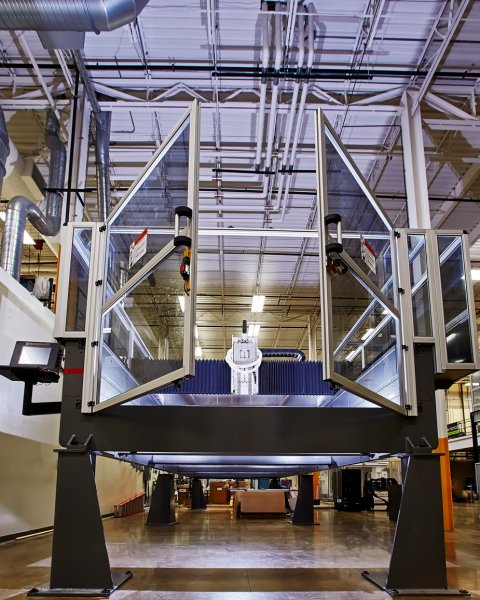From medical devices to airplane components, three-dimensional (3-D) printing is transforming the manufacturing industry.
Wind Energy Technologies Office
May 19, 2016From medical devices to airplane components, three-dimensional (3-D) printing (also called additive manufacturing) is transforming the manufacturing industry. Now, research that supports the Energy Department’s Atmosphere to Electrons (A2e) initiative is applying 3-D-printing processes to create wind turbine blade molds.
This research promises to reduce the cost of blade manufacturing and wind energy overall, as blades represent one of the most expensive components of a wind turbine. The processes currently used to manufacture utility-scale wind turbine blades—which can average over 150 feet in length—are complex, energy-intensive, and time-consuming. Trends toward larger blades, coupled with the drive for global competitiveness, inspired the Energy Department’s Wind Program and the Advanced Manufacturing Office to explore new manufacturing technologies.
As part of an effort to expand the throughput and size of the additive manufacturing process, Oak Ridge National Laboratory partnered with Cincinnati Incorporated to develop the Big Area Additive Manufacturing (BAAM) machine. BAAM created a 3-D-printed replica Shelby Cobra automobile, which was displayed at the Energy Department’s Washington, D.C., headquarters and showcased in Paris at the United Nations Framework Convention and the JEC World Conference. BAAM is capable of printing a staggering 100 pounds of polymer materials per hour, which is 500 to 1,000 times faster than conventional 3-D printers. Moreover, BAAM can print components that are 10 times larger (20 feet long, 8 feet wide, and 6 feet tall) than today’s industrial additive machines.
The technology is also scalable, making the manufacture of other large components a future possibility. For now, the Energy Department will take advantage of the availability of BAAM to evaluate whether it can simplify the manufacture of turbine blade molds. Currently, a “plug” must be manufactured and then used to form a mold out of which fiberglass blades can be constructed. Eliminating the plug by applying 3-D printing directly to the mold process will reduce the costs and amount of time required for blade manufacture.
In this demonstration project, the Energy Department will partner with Oak Ridge, Sandia National Laboratories, NREL, and TPI Composites Incorporated to use 3-D printing in the manufacture of a mold for special scaled-down turbine blades designed to simulate the aerodynamic characteristics of a full-size turbine. These research blades will measure 13 meters (approximately 43 feet) in length and undergo static and fatigue testing at NREL. The blades will then be operated using wind turbines at the Energy Department’s Scaled Wind Farm Technology (SWiFT) facility in Texas. This effort will help researchers study wake aerodynamics—that is, the effects that turbines in close proximity to one another can have on productivity. This research will be used to understand and enhance the efficiency of a complete wind plant, comprised of numerous wind turbines.
Three-dimensional printing is just one way the Energy Department is leading the United States toward a renewable energy future and increasing our nation’s competitiveness through research into new, more efficient technologies.


